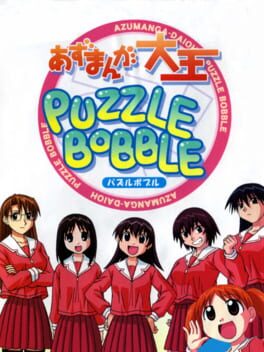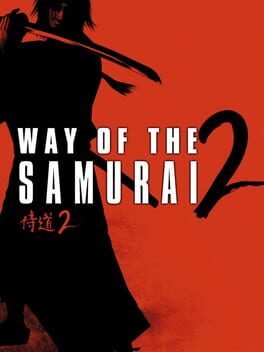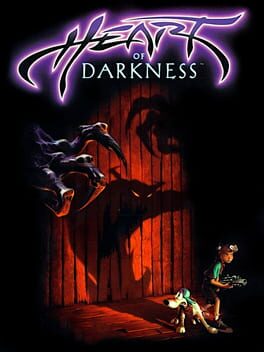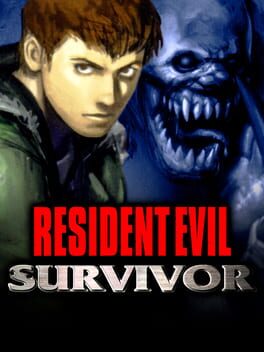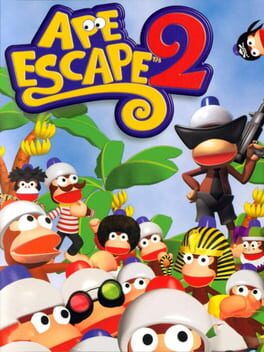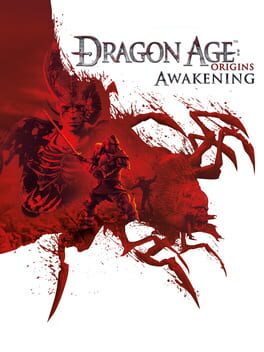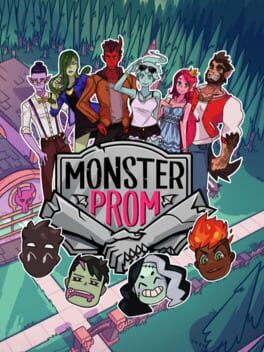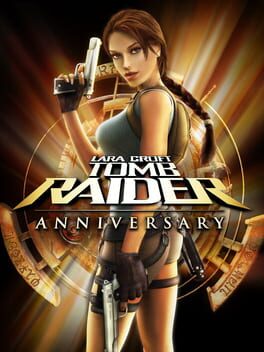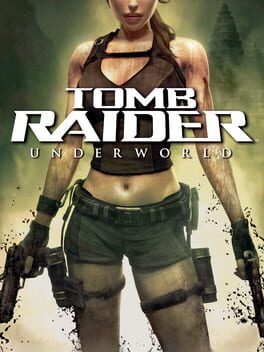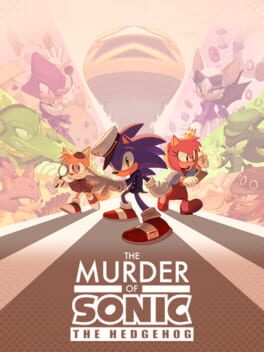gremlintv
BACKER
155 Reviews liked by gremlintv
Muv-Luv Alternative
2006
One of the most phenomenal stories told in any piece of fiction; that special kind of story that gets you fully invested for hours, inspires critical thinking about the game's events and themes, makes you cry (a lot), and sticks with you months after having read it. Thanks to the masterful way Extra and Unlimited set up the plot, the characters and especially the world, Alternative has basically no filler in its 60-70 hour runtime and, imo, earns it's spot as the #1 highest rated visual novel of all time on VNDB.
Dragon's Dogma II
2024
less of a "sequel to dragon's dogma" and more of a "what if dragon's dogma had a budget"
the peaks are absolutely insane but there's still a lot of conflicting subsystems and rpgjank - i was really hoping for they'd add more non-boss monsters (they added uh.. slimes) so you're not just fighting saurians 80% of the time but alas. the new big guys are really fun and the world design is spectacular. i just be running around looking for caves. i be in the caves, mining, digging- you wouldnt get it.
let me be clear, i like the limited fast travel, i like the friction, i like the only-one-save-file-deal-with-it approach. but i also wish i could, like, ask a pawn to throw me over a river or whatever, and like, maybe access more than 4 abilities without having to go to the Menu Stone. or co-op! imagine co-op! goodness! these are the kinds of things i expected to be expanded - they were not. maybe thats on me.
oh it does also run like shit but like, cry about it....
the peaks are absolutely insane but there's still a lot of conflicting subsystems and rpgjank - i was really hoping for they'd add more non-boss monsters (they added uh.. slimes) so you're not just fighting saurians 80% of the time but alas. the new big guys are really fun and the world design is spectacular. i just be running around looking for caves. i be in the caves, mining, digging- you wouldnt get it.
let me be clear, i like the limited fast travel, i like the friction, i like the only-one-save-file-deal-with-it approach. but i also wish i could, like, ask a pawn to throw me over a river or whatever, and like, maybe access more than 4 abilities without having to go to the Menu Stone. or co-op! imagine co-op! goodness! these are the kinds of things i expected to be expanded - they were not. maybe thats on me.
oh it does also run like shit but like, cry about it....
Drakengard
2003
Way of the Samurai 2
2003
Sakura Taisen
2000
this game feels like hiring a master chef, but they have their budget limited to cook for less than 10 dollars: while the individual ingredients may not be the best by themselves, the craft and expertise used to prepare the final dish still give you a good ass meal.
i can't also help but think about actraiser, a game that has some reviews on this site praising its ability to mix genres with excellent results. while i do agree with these, sakura wars also acts as a good contender for that field, merging its srpg and dating sim bits without any issues, managing to provide an engaging experience that doesn't overstay its welcome. also, actraiser doesn't have sumire kanzaki.
i can't also help but think about actraiser, a game that has some reviews on this site praising its ability to mix genres with excellent results. while i do agree with these, sakura wars also acts as a good contender for that field, merging its srpg and dating sim bits without any issues, managing to provide an engaging experience that doesn't overstay its welcome. also, actraiser doesn't have sumire kanzaki.
Wipeout 3
1999
Busted this out for a few hours on a whim to re-live those blissful pre-Y2K vibes and hot damn, it's incredible how this plays almost exactly like you'd expect a modern day Wipeout demake to play. Maybe it's sacrilegious to describe a game's canonical progenitor as "feels like a demake" but what I mean is: I straight up cannot believe that this is running off of 25 year old hardware, it simply looks and plays too well (and too similarly to its modern counterparts) for that to be true.
Seriously, this thing handles like a dream in what seems like 480p + 60fps, and if it wasn't for the fact that you can jam the HYPERTHRUST button and damn near outpace the rendering engine, you'd be forgiven for forgetting that you're playing on a PS1. There's even a cool technical control detail here that I think later games have abandoned, which is that the forward/backward pitch of your craft is something you have to actively manage while racing. This adds to how buttery smooth the game feels as you whip ass up and down and all around the tracks while the choicest late 90s EDM pulses outta your TV.
I legit think I'm gonna get an HD upscaler for the PS1 just so that I can live inside the aesthetic of Sampa Run specifically. Firmly in my "polygons so sharp they could cut ya" era after just three hours of old school Wipeout
Seriously, this thing handles like a dream in what seems like 480p + 60fps, and if it wasn't for the fact that you can jam the HYPERTHRUST button and damn near outpace the rendering engine, you'd be forgiven for forgetting that you're playing on a PS1. There's even a cool technical control detail here that I think later games have abandoned, which is that the forward/backward pitch of your craft is something you have to actively manage while racing. This adds to how buttery smooth the game feels as you whip ass up and down and all around the tracks while the choicest late 90s EDM pulses outta your TV.
I legit think I'm gonna get an HD upscaler for the PS1 just so that I can live inside the aesthetic of Sampa Run specifically. Firmly in my "polygons so sharp they could cut ya" era after just three hours of old school Wipeout
Heart of Darkness
1998
Survivor is such incredible dogshit. It's mystifying that a game so haphazardly designed, incompetently written and laughably executed was made by professionals who are paid to create videogames to sell to people. From the major design oversights to the over-excited tie-ins to the main series' storyline and poorly integrated assets from previous games, I've never played a piece of licensed Sony Computer Entertainment software that felt so much like a fangame made by a 12 year-old. It's a marvel.
For the uninitiated, Resident Evil: Survivor is the Resident Evil lightgun game. Apart from in America, where they were nervous about games where you held a toy gun, and the G-Con support was patched out. It's not designed like a lightgun game, though - It's designed like the laziest Resident Evil game ever made. You play in first-person perspective, walking from rectangular room to rectangular room. You walk forward by pulling the G-Con's trigger while aiming off-screen, and turn by using the gun's A and B buttons. More intricate actions can be performed with awkward double-clicks, but the timing's too tricky to be reliable, so the developers have balanced out the difficulty by making every enemy encounter incredibly easy. If a zombie is in front of you, shoot away until he's dead - he's not really going anywhere. Avoiding enemies is considered an advanced play technique in Survivor, akin to those used by speedrunners. And if he does hurt you, you can easily recover thanks to the copious amount of healing items you'll be carrying - There's no limits to your inventory. No management. No planning. Just pick everything up and carry it until you need it. Pistol ammo is infinite, and the game's over in about an hour anyway.
Lip service is paid to Resident Evil's exploration and puzzles. You enter a new area and there's one locked door and one unlocked one. Go through the unlocked door and you'll find a key for the other one, floating right in front of your face. This is a hardline structural rule to Survivor's map structure that the game very rarely deviates from.
Character models are pulled straight from Resident Evil 2 - Quite an attractive game, given the limitations its artists were working with, and the atmosphere they were evoking. That was a game with a floating camera and pre-rendered backgrounds, though. The character models were never intended to take up three quarters of your television screen, as you determined which giant polygon face to aim at. The animation hasn't been altered either, making Resident Evil Survivor the stiffest-looking lightgun game since Hogan's Alley, where the enemies were supposed to be cardboard cutouts.
The storyline is schlock beyond schlock. I won't dare ruin the thrilling mystery of our amnesiac protagonist's identity for you, but he's without a doubt, the dumbest, most naive hero I've seen in fiction. A joy. I love him. The script is out of this world. The Resident Evil series has frequently utilised low-rate English-speaking actors and models who were within walking distance of Capcom HQ for its cast, but this time, the weird imbalance of English, American, Australian and bilingual European cultural influences seems to have been injected into the script too. I don't know how else to logically dissect lines like “They all had sleepy eyes. One of the girls even slavered.”
Survivor has so many marks of technical weirdness. The way when you shoot a Hunter in mid-leap they hang there like Wile E. Coyote, or the “Return” command appearing twice in your inventory list to mislead you you've scrolled through the whole thing when you're only halfway through your options, or the brightly-lit idyllic family home that sits between open sewer and barb wire fenced-off hellhole, or the implementation of crawling close-quarters enemies in a game where you can't manually look down, or the foley when you wade in thigh-high water sounding like someone pushing a mushy cabbage into a matchbox. It's a fascinating spectacle.
Survivor abandons the need for Ink Ribbons and Typewriters by just making the game very short. There's no mid-game saving. You get to do that when you complete it, as you'll doubtless want to see the alternate routes in New Game+. There's a couple times in the campaign where three doors are presented before you. Choose one, and you'll determine the theme that the next three rooms will take before the paths converge once more. Do you pick the arcade or the hospital? Which wallpaper would you prefer? It's cute that they attempted something.
In spite of all this, I remain very fond of Resident Evil: Survivor. This isn't just a bad Resident Evil game. It's not a miserable experience to play. It isn't Dead Aim. Survivor's most positive attribute is lack of ambition. It's short, simple, and disinterested in challenging the player. The most negative emotion it can evoke is boredom, and that's not much of an issue when it so rapidly takes such dramatic left-turns into sheer lunacy. It's not bereft of positive qualities, either. The texture work is genuinely pretty good, and makes me think they must have had some staff from the main studio work on the game. Before the internet was what it is today, Survivor served as a breezy, accessible way to see a bunch of Resi monsters. I never have a bad time with it. Ironic enjoyment has been deemed an unfashionable concept since the term “hipster” was first coined, but there's nothing insincere about how much pleasure this game brings me, or how hard I push it upon classic Resident Evil fans. I couldn't ever give this incontrovertible icon of badness anything above a 1/5 though. It'd be like giving the blunt force trauma a positive review because it made you talk funny.
For the uninitiated, Resident Evil: Survivor is the Resident Evil lightgun game. Apart from in America, where they were nervous about games where you held a toy gun, and the G-Con support was patched out. It's not designed like a lightgun game, though - It's designed like the laziest Resident Evil game ever made. You play in first-person perspective, walking from rectangular room to rectangular room. You walk forward by pulling the G-Con's trigger while aiming off-screen, and turn by using the gun's A and B buttons. More intricate actions can be performed with awkward double-clicks, but the timing's too tricky to be reliable, so the developers have balanced out the difficulty by making every enemy encounter incredibly easy. If a zombie is in front of you, shoot away until he's dead - he's not really going anywhere. Avoiding enemies is considered an advanced play technique in Survivor, akin to those used by speedrunners. And if he does hurt you, you can easily recover thanks to the copious amount of healing items you'll be carrying - There's no limits to your inventory. No management. No planning. Just pick everything up and carry it until you need it. Pistol ammo is infinite, and the game's over in about an hour anyway.
Lip service is paid to Resident Evil's exploration and puzzles. You enter a new area and there's one locked door and one unlocked one. Go through the unlocked door and you'll find a key for the other one, floating right in front of your face. This is a hardline structural rule to Survivor's map structure that the game very rarely deviates from.
Character models are pulled straight from Resident Evil 2 - Quite an attractive game, given the limitations its artists were working with, and the atmosphere they were evoking. That was a game with a floating camera and pre-rendered backgrounds, though. The character models were never intended to take up three quarters of your television screen, as you determined which giant polygon face to aim at. The animation hasn't been altered either, making Resident Evil Survivor the stiffest-looking lightgun game since Hogan's Alley, where the enemies were supposed to be cardboard cutouts.
The storyline is schlock beyond schlock. I won't dare ruin the thrilling mystery of our amnesiac protagonist's identity for you, but he's without a doubt, the dumbest, most naive hero I've seen in fiction. A joy. I love him. The script is out of this world. The Resident Evil series has frequently utilised low-rate English-speaking actors and models who were within walking distance of Capcom HQ for its cast, but this time, the weird imbalance of English, American, Australian and bilingual European cultural influences seems to have been injected into the script too. I don't know how else to logically dissect lines like “They all had sleepy eyes. One of the girls even slavered.”
Survivor has so many marks of technical weirdness. The way when you shoot a Hunter in mid-leap they hang there like Wile E. Coyote, or the “Return” command appearing twice in your inventory list to mislead you you've scrolled through the whole thing when you're only halfway through your options, or the brightly-lit idyllic family home that sits between open sewer and barb wire fenced-off hellhole, or the implementation of crawling close-quarters enemies in a game where you can't manually look down, or the foley when you wade in thigh-high water sounding like someone pushing a mushy cabbage into a matchbox. It's a fascinating spectacle.
Survivor abandons the need for Ink Ribbons and Typewriters by just making the game very short. There's no mid-game saving. You get to do that when you complete it, as you'll doubtless want to see the alternate routes in New Game+. There's a couple times in the campaign where three doors are presented before you. Choose one, and you'll determine the theme that the next three rooms will take before the paths converge once more. Do you pick the arcade or the hospital? Which wallpaper would you prefer? It's cute that they attempted something.
In spite of all this, I remain very fond of Resident Evil: Survivor. This isn't just a bad Resident Evil game. It's not a miserable experience to play. It isn't Dead Aim. Survivor's most positive attribute is lack of ambition. It's short, simple, and disinterested in challenging the player. The most negative emotion it can evoke is boredom, and that's not much of an issue when it so rapidly takes such dramatic left-turns into sheer lunacy. It's not bereft of positive qualities, either. The texture work is genuinely pretty good, and makes me think they must have had some staff from the main studio work on the game. Before the internet was what it is today, Survivor served as a breezy, accessible way to see a bunch of Resi monsters. I never have a bad time with it. Ironic enjoyment has been deemed an unfashionable concept since the term “hipster” was first coined, but there's nothing insincere about how much pleasure this game brings me, or how hard I push it upon classic Resident Evil fans. I couldn't ever give this incontrovertible icon of badness anything above a 1/5 though. It'd be like giving the blunt force trauma a positive review because it made you talk funny.
Ape Escape 2
2002
a sad example of a sequel completely treading water and failing to expand its series concept a single iota. in many ways you could take my ape escape review and just plop it here without anything changed. many of the positives of the original game stemmed from its novelty in the space of 3D platformers and its excellent psx engine that showcased the hardware at its peak. its sequel seems infinitely lazier and less ambitious in comparison, cribbing extensively from the original with little variation and a lot of repetition. not bad, but terribly disappointing.
-all the original gadgets reappear, but the new ones are rather slight lock-and-key affairs that only serve to increase the amount of time you spend menuing to swap them in. the water cannon, bananarang, and magnet each have their own obstacles that can only be solved using them, and in no cases do the developers attempt to expand upon their usage or make legitimate puzzles involving them. lots of "oh the monkey is in a cage labeled with a banana, time to throw the bananarang" and "look a fire pit, time to use the water cannon" etc.
-dunno if I had rose-tinted glasses in the first game or not but good god the controls are stiff and unresponsive here. hikaru has no smooth speed-up and instead jerks into motion at the slightest touch of the analog stick. his first jump has range but is low, and his second jump is high but awkwardly kills all momentum. the sky flyer also feels less fluid than the original, or maybe I'm just misremembering. regardless, precision platforming felt more strenuous this time around, and the devs seem to have taken notice given that they gutted much of the legitimately difficult trials from the original
-level themes are inconsistent and slapdash compared to the mostly focused time-periods schtick of the original. no context for why I'm anywhere doing anything other than just catching more monkeys! the more elaborate interlocking levels of the original are also dumbed down here to mainly linear courses or maybe a loop here or there. might be giving the original too much credit but again I feel like it also did a better job giving monkeys specific challenges rather than just strewing them across the world haphazardly.
-soichi terada is absent this time around and thus the crystalline breakbeat and house of the original is pushed aside in favor of generic and schmaltzy midi abominations that left me with no other choice than to blare podcasts on top of it. going from a game that so perfectly nailed its quirky atmosphere with a polygonal shonen running around catching heavily-armed monkeys with a net all soundtracked by lite-rave blasts and comedown room leads... to this boring happy-go-lucky generic mascot platformer aesthetic that sucks the life out of the experience. dreadful
-ape escape itself is such a flawed design concept that the lack of changes are really striking. I said in the prior review that the right stick is meant for the camera; more specifically trying to triangulate angles between 1) your movement and position on the left stick 2) the angle of attack or object use on the right stick 3) the erratic movement of the auto-cam is actually less accurate than just having the camera on the right stick in the first place. one game (two really with ape escape 2001) should have been enough to prove this, but ape escape 2 blunders along with all of the same issues, inaccuracies, and frustrations of the original. of all the gadgets, the net is now somehow even more annoying because new cinematic swing animations that play randomly (or maybe when the game thinks you have a guaranteed successful catch?) have such severe windup that the monkey can actually simply walk out of your range during it, leading to an embarassing whiff that begs the question of why such an animation even exists.
the game's biggest positive is that at the same time of all of this it is still ape escape and is still a totally competent 3D platformer that I legitimately enjoyed in a brain-dead podcast game way during the middle section. by that point I already knew that the game was a clunker (after playing the first areas and being completely turned off the game for months) and had not quite reached the endgame (which felt utterly perfunctory and totally devoid of any iteration in challenge over the prior levels). bosses are fine too: functionally on-par with contemporaries with easy-to-parse attack patterns. the vehicle areas are simplistic but nice diversions, and thankfully they aren't over-deployed to the point of becoming stale.
ape escape thrives on its cheeky experimental streak, and unfortunately ape escape 2 lacks that charismatic edge to keep the player engaged. I wasn't expecting to see a series with a concept so fresh and flippant trot out the hits so soon in its chronology. somehow not a surprise sony withheld this one from the states for an entire year only to let ubisoft publish it in their stead.
-all the original gadgets reappear, but the new ones are rather slight lock-and-key affairs that only serve to increase the amount of time you spend menuing to swap them in. the water cannon, bananarang, and magnet each have their own obstacles that can only be solved using them, and in no cases do the developers attempt to expand upon their usage or make legitimate puzzles involving them. lots of "oh the monkey is in a cage labeled with a banana, time to throw the bananarang" and "look a fire pit, time to use the water cannon" etc.
-dunno if I had rose-tinted glasses in the first game or not but good god the controls are stiff and unresponsive here. hikaru has no smooth speed-up and instead jerks into motion at the slightest touch of the analog stick. his first jump has range but is low, and his second jump is high but awkwardly kills all momentum. the sky flyer also feels less fluid than the original, or maybe I'm just misremembering. regardless, precision platforming felt more strenuous this time around, and the devs seem to have taken notice given that they gutted much of the legitimately difficult trials from the original
-level themes are inconsistent and slapdash compared to the mostly focused time-periods schtick of the original. no context for why I'm anywhere doing anything other than just catching more monkeys! the more elaborate interlocking levels of the original are also dumbed down here to mainly linear courses or maybe a loop here or there. might be giving the original too much credit but again I feel like it also did a better job giving monkeys specific challenges rather than just strewing them across the world haphazardly.
-soichi terada is absent this time around and thus the crystalline breakbeat and house of the original is pushed aside in favor of generic and schmaltzy midi abominations that left me with no other choice than to blare podcasts on top of it. going from a game that so perfectly nailed its quirky atmosphere with a polygonal shonen running around catching heavily-armed monkeys with a net all soundtracked by lite-rave blasts and comedown room leads... to this boring happy-go-lucky generic mascot platformer aesthetic that sucks the life out of the experience. dreadful
-ape escape itself is such a flawed design concept that the lack of changes are really striking. I said in the prior review that the right stick is meant for the camera; more specifically trying to triangulate angles between 1) your movement and position on the left stick 2) the angle of attack or object use on the right stick 3) the erratic movement of the auto-cam is actually less accurate than just having the camera on the right stick in the first place. one game (two really with ape escape 2001) should have been enough to prove this, but ape escape 2 blunders along with all of the same issues, inaccuracies, and frustrations of the original. of all the gadgets, the net is now somehow even more annoying because new cinematic swing animations that play randomly (or maybe when the game thinks you have a guaranteed successful catch?) have such severe windup that the monkey can actually simply walk out of your range during it, leading to an embarassing whiff that begs the question of why such an animation even exists.
the game's biggest positive is that at the same time of all of this it is still ape escape and is still a totally competent 3D platformer that I legitimately enjoyed in a brain-dead podcast game way during the middle section. by that point I already knew that the game was a clunker (after playing the first areas and being completely turned off the game for months) and had not quite reached the endgame (which felt utterly perfunctory and totally devoid of any iteration in challenge over the prior levels). bosses are fine too: functionally on-par with contemporaries with easy-to-parse attack patterns. the vehicle areas are simplistic but nice diversions, and thankfully they aren't over-deployed to the point of becoming stale.
ape escape thrives on its cheeky experimental streak, and unfortunately ape escape 2 lacks that charismatic edge to keep the player engaged. I wasn't expecting to see a series with a concept so fresh and flippant trot out the hits so soon in its chronology. somehow not a surprise sony withheld this one from the states for an entire year only to let ubisoft publish it in their stead.
Unlike the other pieces of Dragon Age DLC, which present linear storylines in self-contained levels, Awakening attempts to replicate the structure of the main game, bringing a larger campaign made up of different questlines that the player can choose to tackle in whichever order they wish. Also unlike the other DLC, it was priced at a whopping forty dollars on release, which was almost as much as the main game, so it might as well have had something special going to justify it. Fourteen years ago, my gut told me it wasn't going to. It turns out those suspicions were not entirely unfounded.
The expansion is a direct sequel to the events of the main game. The Warden, now promoted to Warden-Commander, arrives in the fortress of Vigil's Keep within the arling of Amaranthine, which was granted to the Grey Wardens during the epilogue. What should be mere routine quickly spirals into chaos as the fortress is attacked by an army of darkspawn whose commander is somehow capable of human speech. The Warden-Commander now shuffles to repair Vigil's Keep as well as recruit new Grey Wardens to fight this new threat.
From a playtime standpoint alone, the expansion already compares disfavorably, clocking in at a quarter of the playtime of the main game, which should be a sign of how light on content it is. While one might (fairly) object to hours-per-dollar being used to evaluate a game, it's important to note that runtime, in a dense RPG such as Dragon Age, allows the writers to flesh out their characters and worlds much better, and it turns out they desperately needed that, because Awakening lacks both the setups and the cast of the original and struggles to get its main quest going.
The mystery of intelligent darkspawn is an enticing one, and it does present us with two fascinating characters from that faction, but the campaign rushes through the moments where they might have been developed, and it is only near the very end of the campaign that we're presented with their true purposes and with the nature and scale of the threat they represent: until then, we're mostly tasked with the administration of the arling and recruitment of new Grey Wardens, doing quests that, while fun, at least at first, seem unrelated to the darkspawn.
Even though the work as arlessa is far from the dramatic race against the clock we had before, it's possible to tell fascinating character-driven stories against a bureaucratic backdrop, but not only does it require a wealth of in-game events -- which again, the short runtime does not allow for -- strong characters with good chemistry are needed, and Awakening is lacking in the latter, and arguably the former as well.
Apart from Oghren, who has somehow become even more vile since Origins, the party is composed of entirely new characters, and it's a real mixed bag. Justice is the one standout, a spirit from the Fade trapped in the body of a Grey Warden against this will who's then forced to experience the world of mortals through the eyes of one. His points of view on the events of the game are fascinating and fresh, and his lack of knowledge about the real world organically creates conflicts of ideas with the rest of the party without him having to be a dick to them. Justice also experiences consistent growth throughout the game.
The rest are just... eh. Velanna and Sigurh are forgettable: there could have been something going for them, but at the breakneck pace of Awakening, there just wasn't enough time to flesh out their characters and they just end up as More Grey Wardens™. Likewise, Nathaniel is an interesting proposition for a character that needed more time to work out his conflicts with the Human Noble without seeming whiny -- my first impulse, which I had to reload a save to fix, was to execute him on the first meeting when he asked to be killed instead of conscripted.
Finally, Anders: his DA2 incarnation may not garner all the love in the world, but at least there, there's a better balance between the multiple facets of his character, and he displays a wider range of emotions. In Awakening, he spends most of his time playing the smartass, to a point where leaving him in the party for too long may drive one insane. It's interesting to see the inversion that will happen in DA2, where Justice will be the one that reads as shallow and single-minded, while Anders is more complex.
Either way, another point of the setting that gets lost due to the rushed storyline is the weight to the order of the Grey Wardens and their practices. The Right of Conscription gets waved around like it's nothing, and the Joining ritual loses both its mystery and seriousness, becoming as casual as inviting someone out for a darkspawn-flavored milkshake. The pacing also ruins points that Awakening itself tries to bring up, with lots of quests petering out before reaching a fulfilling conclusion. A few sidequests, like the Blight Orfans (sic) questline, make for great examples of this, but nothing can top the abysmal conclusion to the campaign, which sees the party turn their back to the charred corpse of the final boss immediately as it dies and... cuts straight to the ending slideshow.
The cherry on top are the bugs. Origins is far from a clean gaming experience and a trip down the wiki will quickly demonstrate that, but Awakening is on a whole other level: multiple pieces of equipment can be lost upon entering the DLC and entire questlines can just fall apart or be missed if the player dares do missions in certain orders or remove companions from the party when the game doesn't expect them to. By the end of my playthrough, three entire questlines were uncompletable, including Sigurh's character missions and the Vigil's Keep upgrades. And supposedly, even with the game done, its bugs are still with me, as the imported save can have other issues and misrepresent the playthrough.
There's a semblance of something good going on in Awakening, but engaging with it mostly brings disappointment over disappointment. In the end, it feels like a tacked-on, overpriced expansion to Dragon Age: Origins, lacking both the scale and weight of that game. Owners of the Ultimate Edition will enjoy one more silly adventure to take their Grey Warden on if they can tolerate the hurdles, but will probably forget about it shortly after. As for the people who paid full-price back in the day... Oof.
The expansion is a direct sequel to the events of the main game. The Warden, now promoted to Warden-Commander, arrives in the fortress of Vigil's Keep within the arling of Amaranthine, which was granted to the Grey Wardens during the epilogue. What should be mere routine quickly spirals into chaos as the fortress is attacked by an army of darkspawn whose commander is somehow capable of human speech. The Warden-Commander now shuffles to repair Vigil's Keep as well as recruit new Grey Wardens to fight this new threat.
From a playtime standpoint alone, the expansion already compares disfavorably, clocking in at a quarter of the playtime of the main game, which should be a sign of how light on content it is. While one might (fairly) object to hours-per-dollar being used to evaluate a game, it's important to note that runtime, in a dense RPG such as Dragon Age, allows the writers to flesh out their characters and worlds much better, and it turns out they desperately needed that, because Awakening lacks both the setups and the cast of the original and struggles to get its main quest going.
The mystery of intelligent darkspawn is an enticing one, and it does present us with two fascinating characters from that faction, but the campaign rushes through the moments where they might have been developed, and it is only near the very end of the campaign that we're presented with their true purposes and with the nature and scale of the threat they represent: until then, we're mostly tasked with the administration of the arling and recruitment of new Grey Wardens, doing quests that, while fun, at least at first, seem unrelated to the darkspawn.
Even though the work as arlessa is far from the dramatic race against the clock we had before, it's possible to tell fascinating character-driven stories against a bureaucratic backdrop, but not only does it require a wealth of in-game events -- which again, the short runtime does not allow for -- strong characters with good chemistry are needed, and Awakening is lacking in the latter, and arguably the former as well.
Apart from Oghren, who has somehow become even more vile since Origins, the party is composed of entirely new characters, and it's a real mixed bag. Justice is the one standout, a spirit from the Fade trapped in the body of a Grey Warden against this will who's then forced to experience the world of mortals through the eyes of one. His points of view on the events of the game are fascinating and fresh, and his lack of knowledge about the real world organically creates conflicts of ideas with the rest of the party without him having to be a dick to them. Justice also experiences consistent growth throughout the game.
The rest are just... eh. Velanna and Sigurh are forgettable: there could have been something going for them, but at the breakneck pace of Awakening, there just wasn't enough time to flesh out their characters and they just end up as More Grey Wardens™. Likewise, Nathaniel is an interesting proposition for a character that needed more time to work out his conflicts with the Human Noble without seeming whiny -- my first impulse, which I had to reload a save to fix, was to execute him on the first meeting when he asked to be killed instead of conscripted.
Finally, Anders: his DA2 incarnation may not garner all the love in the world, but at least there, there's a better balance between the multiple facets of his character, and he displays a wider range of emotions. In Awakening, he spends most of his time playing the smartass, to a point where leaving him in the party for too long may drive one insane. It's interesting to see the inversion that will happen in DA2, where Justice will be the one that reads as shallow and single-minded, while Anders is more complex.
Either way, another point of the setting that gets lost due to the rushed storyline is the weight to the order of the Grey Wardens and their practices. The Right of Conscription gets waved around like it's nothing, and the Joining ritual loses both its mystery and seriousness, becoming as casual as inviting someone out for a darkspawn-flavored milkshake. The pacing also ruins points that Awakening itself tries to bring up, with lots of quests petering out before reaching a fulfilling conclusion. A few sidequests, like the Blight Orfans (sic) questline, make for great examples of this, but nothing can top the abysmal conclusion to the campaign, which sees the party turn their back to the charred corpse of the final boss immediately as it dies and... cuts straight to the ending slideshow.
The cherry on top are the bugs. Origins is far from a clean gaming experience and a trip down the wiki will quickly demonstrate that, but Awakening is on a whole other level: multiple pieces of equipment can be lost upon entering the DLC and entire questlines can just fall apart or be missed if the player dares do missions in certain orders or remove companions from the party when the game doesn't expect them to. By the end of my playthrough, three entire questlines were uncompletable, including Sigurh's character missions and the Vigil's Keep upgrades. And supposedly, even with the game done, its bugs are still with me, as the imported save can have other issues and misrepresent the playthrough.
There's a semblance of something good going on in Awakening, but engaging with it mostly brings disappointment over disappointment. In the end, it feels like a tacked-on, overpriced expansion to Dragon Age: Origins, lacking both the scale and weight of that game. Owners of the Ultimate Edition will enjoy one more silly adventure to take their Grey Warden on if they can tolerate the hurdles, but will probably forget about it shortly after. As for the people who paid full-price back in the day... Oof.
Monster Prom
2018
Got the flu for the last few days and just decided to return to this game for an easy time. Just a goofy little party game/dating sim. Aggressively horny and drug-filled, but that's kind of the point. The mechanics are styled like the Yawhg. You are given a random event and a prompt to respond to. Each option is tied to a specific stat. Succeeding a prompt just involves a general stat check. Succeeding the stat gets you a stat boost and a heart towards whatever character the game thinks you're trying to romance. Failing means a stat cost and... still a heart, but not as many heart points as you would have gotten. If you're on a secret ending route, the path ends immediately and you're thrust
Most of the default endings/secret endings are just taking the already absurd antics to new heights, but sometimes a route will decide to dive into some surprising heart for a game this intentionally stupid. The Support Group and Ice Queen routes are specifically designed to fail. Your stat checks will never succeed, you can't force yourself into these people's lives. Your charming antics become stalking and you're just making the characters uncomfortable. They can only end with the player going "well fuck, I'm being a real asshole, I'll give them some space." And there's something very sincere in that. Other dating vns have deconstructed the premise of this genre before, perhaps with more subtlety, but I did admire the game for being willing to drop its seemingly unapologetic horniness to be like "hey man, this shit has to be consensual, y'know?" A fun little thing.
Most of the default endings/secret endings are just taking the already absurd antics to new heights, but sometimes a route will decide to dive into some surprising heart for a game this intentionally stupid. The Support Group and Ice Queen routes are specifically designed to fail. Your stat checks will never succeed, you can't force yourself into these people's lives. Your charming antics become stalking and you're just making the characters uncomfortable. They can only end with the player going "well fuck, I'm being a real asshole, I'll give them some space." And there's something very sincere in that. Other dating vns have deconstructed the premise of this genre before, perhaps with more subtlety, but I did admire the game for being willing to drop its seemingly unapologetic horniness to be like "hey man, this shit has to be consensual, y'know?" A fun little thing.
I originally gave this a 2 as I felt it was a very cynical remake, and while I think there is some cynicism baked into it, I don't think it's completely without merit or compassion towards to the original. It has a lot of fun playing around with the original's rock-solid level design and puzzles, making it genuinely very engaging for longtime fans of Tomb Raider.
It also goes without saying that, being based off of Core's original game, this is the best Tomb Raider game that Crystal Dynamics ever made, which is ABSOLUTELY the back-handed compliment it sounds like. Without their really rotten design impulses, there is nothing dragging down Anniversary quite like what happens in Legend and Underworld.
Unfortunately, this is still the Gex team, so they show their asses in different ways throughout this experience. The main one to me, being the terrible, terrible combat. Just inept attempts at action, floaty and without heft, a dysfunctional camera not cooperating well when the game spawns in gorillas to gank you in a cramped corridor. Changing the boss fights to include horrible fucking ungodly QTE sequences should be enough to drop this game to a 1 it's so putrid. The T-rex in the Lost Valley is exciting because of how little fanfare there is: the screen shakes and suddenly a giant fucking dinosaur is barrelling towards you. The player has to make a snap judgement on how to react. Turning that into a QTE and a "Get the boss to ram into the wall" fight is something that only the developers of Gex would think is a good idea.
Platforming games are often sewn at the hip to some disastrous combat mechanics, and Anniversary's almost manage to usurp The Sands of Time's Throne of Shit in regards to them. Which is amusing considering how much of this game (and Legend) really owes itself to Sands of Time.
Sands of Time is very silky smooth though. It's like playing a game from the future compared to this.
Sands of Time came out in 2003 btw.
The R1 button being an all-around context button, the more linear layout of platforming challenges, and the camera being very good at snapping to cinematic angles that give you a readable look at the environment are the secret sauce that makes the Sands of Time hum. When you slow it down and start adding complications to the proceedings, it becomes very janky and sloppy feeling. This is doubly so when the development team is the same one who made Gex.
Lara in TR96 controls the same all the time: she is the model of consistency in a video game. There is an unprecedented freedom in that game of mastering her control scheme because once you do, the game is yours to roam free! Anniversary by contrast feels much more rigid in what you can do, as trying to do platforming challenges out of order will have Lara just flatly refuse to grab a ledge or clip through poles, and the Gex team are VERY bad at signposting so you will be doing this without even understanding why you died. In brief instances where things run smoothly, there is a real glimpse at platforming goodness here. The game just refuses to get going or focus on its strengths, instead in a tug-of-war with this insecurity about what Tomb Raider is and dogged desire to make something new.
While it can be very fun and loving in its tributes to Tomb Raider, it mostly feels clumsy and insecure. It's the game equivalent of "I love this game but it's soooo bad" reviews, just totally lacking in the sincerity that makes the original game actually amazing.
It also goes without saying that, being based off of Core's original game, this is the best Tomb Raider game that Crystal Dynamics ever made, which is ABSOLUTELY the back-handed compliment it sounds like. Without their really rotten design impulses, there is nothing dragging down Anniversary quite like what happens in Legend and Underworld.
Unfortunately, this is still the Gex team, so they show their asses in different ways throughout this experience. The main one to me, being the terrible, terrible combat. Just inept attempts at action, floaty and without heft, a dysfunctional camera not cooperating well when the game spawns in gorillas to gank you in a cramped corridor. Changing the boss fights to include horrible fucking ungodly QTE sequences should be enough to drop this game to a 1 it's so putrid. The T-rex in the Lost Valley is exciting because of how little fanfare there is: the screen shakes and suddenly a giant fucking dinosaur is barrelling towards you. The player has to make a snap judgement on how to react. Turning that into a QTE and a "Get the boss to ram into the wall" fight is something that only the developers of Gex would think is a good idea.
Platforming games are often sewn at the hip to some disastrous combat mechanics, and Anniversary's almost manage to usurp The Sands of Time's Throne of Shit in regards to them. Which is amusing considering how much of this game (and Legend) really owes itself to Sands of Time.
Sands of Time is very silky smooth though. It's like playing a game from the future compared to this.
Sands of Time came out in 2003 btw.
The R1 button being an all-around context button, the more linear layout of platforming challenges, and the camera being very good at snapping to cinematic angles that give you a readable look at the environment are the secret sauce that makes the Sands of Time hum. When you slow it down and start adding complications to the proceedings, it becomes very janky and sloppy feeling. This is doubly so when the development team is the same one who made Gex.
Lara in TR96 controls the same all the time: she is the model of consistency in a video game. There is an unprecedented freedom in that game of mastering her control scheme because once you do, the game is yours to roam free! Anniversary by contrast feels much more rigid in what you can do, as trying to do platforming challenges out of order will have Lara just flatly refuse to grab a ledge or clip through poles, and the Gex team are VERY bad at signposting so you will be doing this without even understanding why you died. In brief instances where things run smoothly, there is a real glimpse at platforming goodness here. The game just refuses to get going or focus on its strengths, instead in a tug-of-war with this insecurity about what Tomb Raider is and dogged desire to make something new.
While it can be very fun and loving in its tributes to Tomb Raider, it mostly feels clumsy and insecure. It's the game equivalent of "I love this game but it's soooo bad" reviews, just totally lacking in the sincerity that makes the original game actually amazing.
Relaxing, easily-enjoyable Tomb Raider classic where you can sit down for a couple hours and enjoy some well-crafted platforming, puzzle-solving, and picturesque views of Lara's ass and titties. Ogling aside, Lara's very easy to like in this game, the perfect balance between snarky, experienced adventurer and curious, analytical underdog. It's easy to root for her and listen to her British ramblings about whatever neat spot she's currently in (just goes to show that you don't need absurd, fetishistic amounts of tragedy to make a character likable, Tomb Raider 2013), and the campy, grandiose action-adventure plotline is a lot of casual fun to follow along with. I enjoy the parkour and the dynamic, tricky wall-climbing quite a bit, combat easily and naturally free-flows into the exploration thanks to infinite ammo and an auto-aim to keep the pace going, and patches of this game looks surprisingly good for something available on both the X360 and the Wii (so FYI, if you have Dolphin Emulator, this is something you can easily play).
With all that in mind, the biggest draw with this game is the blatant lack of overall polish. The well-crafted and gorgeous levels are often underscored by frankly buggy controls that struggle to make sharp turns or even basic movements properly. The intro level in the burning building is a terrible tutorial, poorly telegraphed and confusing and full of too many tight corridors to prepare you for the more open-ended and high-ceilinged areas up ahead. The map also fucking sucks. It's a confusing and unhelpful sonar-looking map that rarely gives you a good idea on where you are or where to go next, something that's pretty damning in a game about exploration. Lara also feels just a little too weak in this game - one minor slip and a brief fall could potentially kill her, something that never stops feeling both incredibly silly and groan-inducing. At least the time between deaths and respawns are pretty fucking brisk so you don't lose that much time, but it's still absurd for Lara to survive numerous bullets to the face whereas falling off a one-story roof sends her straight to heaven.
That said, Underworld is a solid Tomb Raider game, taking what works about the classic games and adapting it to newer consoles with a fair amount of grace. Underworld could have used some more time cooking in the oven - some basic levels of polish and fine-tuning would have gone a long way in making Underworld really pop. But as it stands, Underworld is a very casually enjoyable game that feels good to kick back and play in spite of the occasional moment of buggy movement or the intermittently jarring design choice.
With all that in mind, the biggest draw with this game is the blatant lack of overall polish. The well-crafted and gorgeous levels are often underscored by frankly buggy controls that struggle to make sharp turns or even basic movements properly. The intro level in the burning building is a terrible tutorial, poorly telegraphed and confusing and full of too many tight corridors to prepare you for the more open-ended and high-ceilinged areas up ahead. The map also fucking sucks. It's a confusing and unhelpful sonar-looking map that rarely gives you a good idea on where you are or where to go next, something that's pretty damning in a game about exploration. Lara also feels just a little too weak in this game - one minor slip and a brief fall could potentially kill her, something that never stops feeling both incredibly silly and groan-inducing. At least the time between deaths and respawns are pretty fucking brisk so you don't lose that much time, but it's still absurd for Lara to survive numerous bullets to the face whereas falling off a one-story roof sends her straight to heaven.
That said, Underworld is a solid Tomb Raider game, taking what works about the classic games and adapting it to newer consoles with a fair amount of grace. Underworld could have used some more time cooking in the oven - some basic levels of polish and fine-tuning would have gone a long way in making Underworld really pop. But as it stands, Underworld is a very casually enjoyable game that feels good to kick back and play in spite of the occasional moment of buggy movement or the intermittently jarring design choice.



